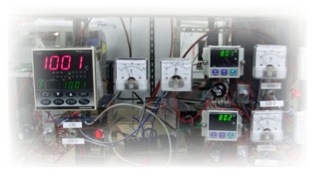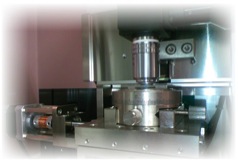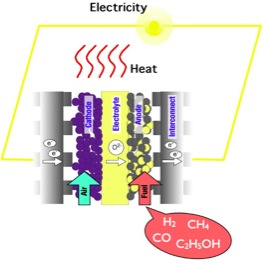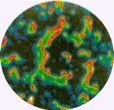 |
 |
 |
 |
Solid oxide fuel cell consists mainly of ceramic materials and operates at high temperatures as 600°C to 1000°C. Various fossil fuels can be utilized with high efficiency.We are supporting technology developments especially on improvements of efficiency, reliability and durability based on fundamental researches.
|
 |

 |
- Basic research for improving reliability and durability of SOFC (NEDO Project)
Mechanical instability is one of the most serious issues of SOFCs which are made of ceramics. Under the financial support by NEDO, we are collaborating with several research groups inside and outside the university to establish an academic basis for qualitative evaluation of mechanical reliability. It includes measurement of physical and mechanical properties of the materials at operating conditions, numerical modeling of SOFCs, and application of in-situ monitoring technologies to cell and stacks.
|
- Development of electrode materials for high performance SOFC
Electrode performance is a critical factor to determine the energy conversion efficiency of SOFC. Development of new electrode material is attempted from the bases of defect chemistry and nano-ionics.We found a possible combination of materials that may improve the oxygen incorporation rate of LaCoO3 based cathode. |
|
 |
Solid state ionic materials, allowing ions to be transported inside, are utilized in various energy conversion devices, such as fuel cells, secondary batteries, and steam electrolyzers. We are trying to find new ionic conductors, and to elucidate the kinetics at the surface and interface of the ioincs materials.
|
 |
- Development of new proton conductor
One of our research interests is proton conduction materials operated in the temperature range of 300°C to 1000°C. We have succeeded to develop the series of phosphate-based proton conductors, which differs from the oxide-based proton conductors reported so far, working at middle to high temperatures. Proton conduction mechanism of them has been investigated using optical measurements and quantum chemical calculations. In addition, system research relating to fuel cells etc. using the series of phosphate-based proton conductors is also ongoing.
|
 |
- Chasing oxygen inside solids
In solid oxide fuel cells, oxygen may flow not uniformly through the porous electrode and in polycrystalline electrolytes. The oxygen transport pathway reflects the reaction and transport kinetics, and gives useful information for designing the materials of high performance and reliability. Although oxygen is invisible, we are trying to develop "in-situ" monitoring techniques to know the oxygen transport pathway.
|
|
 |
Technology Development Toward Hydrogen Energy Society
Fossil fuels is converted into hydrogen via reforming and purification steps. Hydrogen separation using palladium alloy membrane is a promising technique to obtain high purity hydrogen with high efficiency. We contributed to clarify the effect of coexisting gases on the hydrogen permeation rate through the palladium-silver membranes.
|
|
|
|

